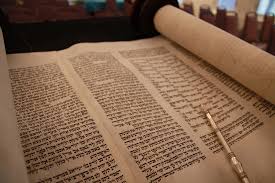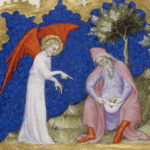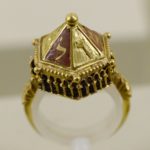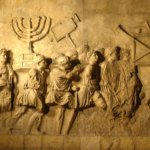Rabbi Yochanan and Raish Lakish: Living with Torah
It is a tale with a sad ending. It begins with sunshine and light but it ends with darkness and despair. It begins with clarity of vision but it ends in muddy confusion. The original tale is told in Baba Metzi’a, on Daf 84, Amud Alef. Here is my version.
On a warm, clear day, Rabbi Yochanan went swimming in the Jordan River. “And just who was this Rabbi Yochanan?” you ask. Rabbi Yochanan was a pre-eminent Rabbinic scholar from the Galilee town of Tzippori. He was on his way to becoming the greatest sage of his time. He was responsible for the Talmud Yerushalmi. And he was a most handsome fellow!
So, where were we? Oh, yes, Rabbi Yochanan was swimming in the river. All of a sudden, in jumps a striking fellow named Shimon. Rabbi Yochanan immediately recognized this second bather for what he was, namely a Jewish bandit. Recognizing a strong, muscular fellow when he sees one, Rabbi Yochanan called out to him, “Your strength was meant for Torah!”
“And your beauty was meant for women!” replied the robber.
“Do Teshuva, return to the Torah of your youth and you can marry my sister, who is even more beautiful than me!” countered Rabbi Yochanan.
To make a short story even shorter, the bandit agreed. Funny, though, after accepting Rabbi Yochanan’s challenge to study Torah seriously and to become a Ba’al Teshuva, Shimon the bandit could not manage to jump back onto the riverbank. My Chavruta, Rashi explains that after placing the yoke to Torah and Mitzvot on his shoulders, Shimon lacked the strength for his usual acrobatics.
The Beginning of a lifelong friendship and partnership between two outstanding personalities.
The Gemara reports that Rabbi Yochanan taught his new disciple, Shimon ben Lakish, Bible, and Mishnah and made out of him a great man. Rabbi Yochanan lived to be almost 100 years old. Rabbi Shimon ben Lakish is fondly known as Raish Lakish was about 10 years his junior. The first half of our tale must have taken place when both men were relatively young. Thus, we can safely assume that they studied together for close to seventy years! Is it any wonder that at times Rabbi Yochanan calls Raish Lakish, “my right hand”? Aside from being brothers-in-law yes, Raish Lakish did marry Rabbi Yochanan’s beautiful sister they were inseparable, like brothers. To the untrained eye, it would seem that they were formidable adversaries, for they seem to argue with each other on almost every page of the Talmud and Midrash. Yes, they argued vehemently about every major halachic and aggadic issue. However, it was a true labor of love between two scholars, between a life-long mentor and a life long disciple. Step into any Bayt Midrash and you can hear the Rabbi Yochanan’s and Raish Lakish’s of today arguing at the top of their lungs, but you can see in their eyes, in their gestures that they are also the best of friends.
For almost seventy years Rabbi Yochanan and Raish Lakish were a successful Chavruta, learning pair. Until one day, when the discussion in the Bayt Midrash was turned to swords and knives. When can a sword or a knife or a long knife or a spear or a hand sickle or a sickle for harvesting become ritually unclean, Tamay? Everyone agreed that these items can become ritually unclean, Tamay when the smithy is finished making them. So when is the manufacturing process complete? For an authoritative answer, all eyes and ears were turned to the two elder rabbinic statesmen who were present. Sure enough, an argument ensued. Rabbi Yochanan said, “They can become ritually unclean, Tamay, from the time they are shaped by fire in the furnace.”
Raish Lakish disagreed
“They can become ritually unclean, Tamay, only after they have been polished with water.”
Let’s take a moment to reflect. My other Chavruta, Tosafot, raised an interesting question. Here, we have two of the greatest, if not the greatest sages of their time making a fundamental error. The Mishnah in Kaylim, which deals with these issues, states exactly when the manufacturing process is considered completed for each kind of knife or bladed object. The only problem is that neither Rabbi Yochanan’s nor Raish Lakish’s answers agree with the statements found in the Mishnah. That these two gentlemen should not remember or know a Mishnah is inconceivable! Tosafot suggested an answer. However, it raises more questions than it answers. So, back to our tale, but don’t forget this question. It is a crucial one.
Here is the rest of the tale, till the bitter end.
“Well, a bandit surely knows banditry!” exclaims Rabbi Yochanan, in response to Raish Lakish’s answer, implying that Raish Lakish certainly would know all there is to know about swords and knives.
“What good have you done for me?” asks Raish Lakish. “Before, they my fellow robbers – called me, Rebbe, and here in the Yeshiva – they call me, Rebbe.”
“The good I have done for you,” replied Rabbi Yochanan, “is that I have brought you under the wings of the Shechinah.”
Rabbi Yochanan became so upset that he could not think straight, while Raish Lakish became sick, literally sick, deathly sick from this argument.
While Raish Lakish lay dying in his bed, his wife came running to her brother. With tears pouring down her cheeks she pleaded with her brother to pray for his friend Raish Lakish. Rabbi Yochanan refused.
“Do it for his children,” she cried, “so they will not become orphans.”
Rabbi Yochanan answered by quoting the prophet, Yirmiyahu (49:11), “She has left orphans, I will support them.”
“Do it so I will not become a widow!” she screamed at him.
Again her brother replied with a quote, the remainder of the verse from Yirmi’yahu, “Your widows will trust in me.”
Raish Lakish died
Afterward, Rabbi Yochanan was very sorry. His colleagues asked, “Who can we send to study with him so he will return to his former self?” They finally sent the sharpest student among them, Rabbi Elazar ben Pedat. He went and sat with Rabbi Yochanan. Every time Rabbi Yochanan would say something, Rabbi Elazar ben Pedat would quote a bit of Mishnaic material to support the statement.
Finally, Rabbi Yochanan could not stand it any longer. He said to Rabbi Elazar, “Do you really consider yourself to be like ben Lakish? Whenever I said something, Raish Lakish would pepper me with 24 questions and I’d fire back 24 answers. That is how our Torah grew. And all you can say is that the Baraita supports my opinion. Don’t you think I know that already?!” Rabbi Yochanan turned away and began to cry. “Where is ben Lakish? Where is ben Lakish?” He asked over and over again, each time raising his voice louder and louder until he became totally confused.
The Rabbis prayed that God has mercy and compassion for their colleague, Rabbi Yochanan. As a result, he, too, died.
What happened here? For almost 70 years these two men were as close as brothers. The give and take between them have immeasurably enriched the great tapestry of the Torah and the very fabric of our lives. How many hundreds on laws are based on their opinions! And in the end, they upset and insult each other to the point that they die! This is tragedy bordering on absurdity.
The answer to these questions is built on two assumptions. The first is that the Gemara is not a history book. The purpose of the tale is not to be found in the historical facts per se. Rather, the Rabbi of the Talmud and Midrash tell us these stories to teach us something. And that something is supposed to affect our lives, here, today.
The second assumption is the question raised by our friends the authors of the Tosafot.
Why would Rabbi Yochanan and Raish Lakish argue about a well-known Mishnah text?
They aren’t. A quick look back at the exchange of words that follows their expressed opinions will show that this is not simple halachic disagreement. Rather, something else, something much deeper is going on here.
What started as a halachic question in the Bayt Midrash became a sharp argument about Teshuva. The question was when can a knife theoretically become ritually impure? The opposite of ritual impurity is Taharah, ritual purity. Only something that is pure, holy, and whole runs the risk of becoming impure, profaned, and deficient. So when does a Ba’al Teshuva finish the process of Teshuva? When does a Ba’al Teshuva become pure and holy to the point that he or she is at risk of becoming impure?
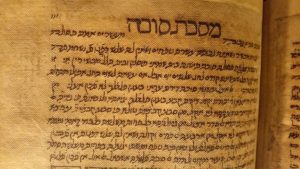 Rabbi Yochanan answers that the process of Teshuva ends when the fire has burned away the individual’s former life, thereby fashioning a new life, a new person.
Rabbi Yochanan answers that the process of Teshuva ends when the fire has burned away the individual’s former life, thereby fashioning a new life, a new person.
Raish Lakish, the Ba’al Teshuva, replies that the process is finished when the individual has been polished by water. Water is the metaphor for the Torah. When the individual has totally immersed himself in Torah, when the Ba’al Teshuva has totally adopted a life of Torah and Mitzvot, then the process is finished, even if he retains certain elements of his former life.
“After all these years, you still remember your knives?” asked Rabbi Yochanan in dismay. In the most derogatory and demeaning manner, Rabbi Yochanan accuses Raish Lakish of not having given up his former life as a bandit.
Raish Lakish replies, “According to you, I am no better off here, as the head of the Yeshiva, than I was as head of my gang of robbers.”
“What are you talking about?” screams Rabbi Yochanan. “I brought you back to God! Don’t you see the difference between a life of banditry and a life of Torah after all these years?”
In the course of their seventy years together, they never raised the issue. And if Rabbi Yochanan had his doubts about his lifelong friend, he never expressed them out loud, until now.
Raish Lakish turned away broken-hearted.
Raish Lakish went home, to bed, to die.
Rabbi Yochanan and Raish Lakish represent two different models of living a life of Torah. Rabbi Yochanan is the model of “Torah is life.” There is no life outside of Torah. His motto comes from Pirkay Avot (5:22), “Turn it (the Torah) over again and again, for everything is in it.” The swirling world around, outside of Torah is at least irrelevant, if not downright dangerous. You run the risk of becoming unclean, Tamay, when you encounter it. If you still remember all there is to know about knives, then you are still a bandit!
Raish Lakish is the model of “life with Torah.” Through the eyes of the Torah, we look at the world around us. With the ethics of Torah to guide us, we live in the wide world. Optimally, we become living, breathing, bipedal Sifray Torah living in a world teeming with both the good and the bad, with beauty and ugliness. For a Ba’al Teshuva to remember his former life and to continue to be involved in the valuable and good parts of that life is positive thing, for that is what a life with Torah is all about anyway. Torah teaches us the correct way for living in the world. Becoming a Ba’al Teshuva does not require one to give up art, literature, and music, because the observant Jew should also be enjoying the same art, literature and music. To still know all there is to know about knives does not mean you are still a bandit!
Rabbi Yochanan’s bull-headed and foolish stubbornness does not allow him to see his error until it is too late. Ignoring the pleas of his sister, he allows Raish Lakish to die of a broken heart.
Poor Reb Elazar ben Pedat meant well. He tried his best. But how can you argue with a sage so wise that everything he says is true? It wasn’t Reb Elazar’s own, personal, subjective opinion. Rather, every word Rabbi Yochanan uttered could be substantiated by proofs from other sources. And poor Rabbi Yochanan! He discovers his loss when it is too late. Raish Lakish is gone. Only when Raish Lakish is gone forever does Rabbi Yochanan finally see the value in Raish Lakish’s knives. Contact and involvement with the world outside of Torah creates the challenge, the questions that enrich the Torah itself. The twenty-four questions and answers are equal to the unimpeachable, unchangeable 24 books of the Bible. Nevertheless, the questions and the answers are the essences of the Oral, Rabbinic tradition. They make the inanimate words scripted on the parchment come alive!
“Oh, Raish Lakish! Oh, Raish Lakish! Where are you now?!” wails Rabbi Yochanan. “Where are you? Come back to me so I can tell you I was wrong. You were right. I apologize! I am, so, so sorry.” Realizing his error, deeply regretting the loss of his best friend, his finest disciple, Rabbi Yochanan descended into an irreversible depression. With sublime sensitivity, his colleagues pray that God relieves Rabbi Yochanan’s misery. God responds by reuniting Rabbi Yochanan with his dear Raish Lakish in the world that is all good.
This final clash of Torah titans was a tournament with no victors. The tragic deaths of Rabbi Yochanan and Raish Lakish are the bitter end to an otherwise glorious tale of the labor and love of the Torah. As we peruse page after page of Talmud, encountering time and again these two wise men, we must remember the final lesson they taught us, the expensive lesson that cost both their lives. The life of the Torah is only enriched when it rises to the challenges thrown at it by living in the wide world that surrounds us. As Raish Lakish taught, the more we polish ourselves through immersion in the waters of Torah, the better prepared we will be to personally rise to the challenge.

